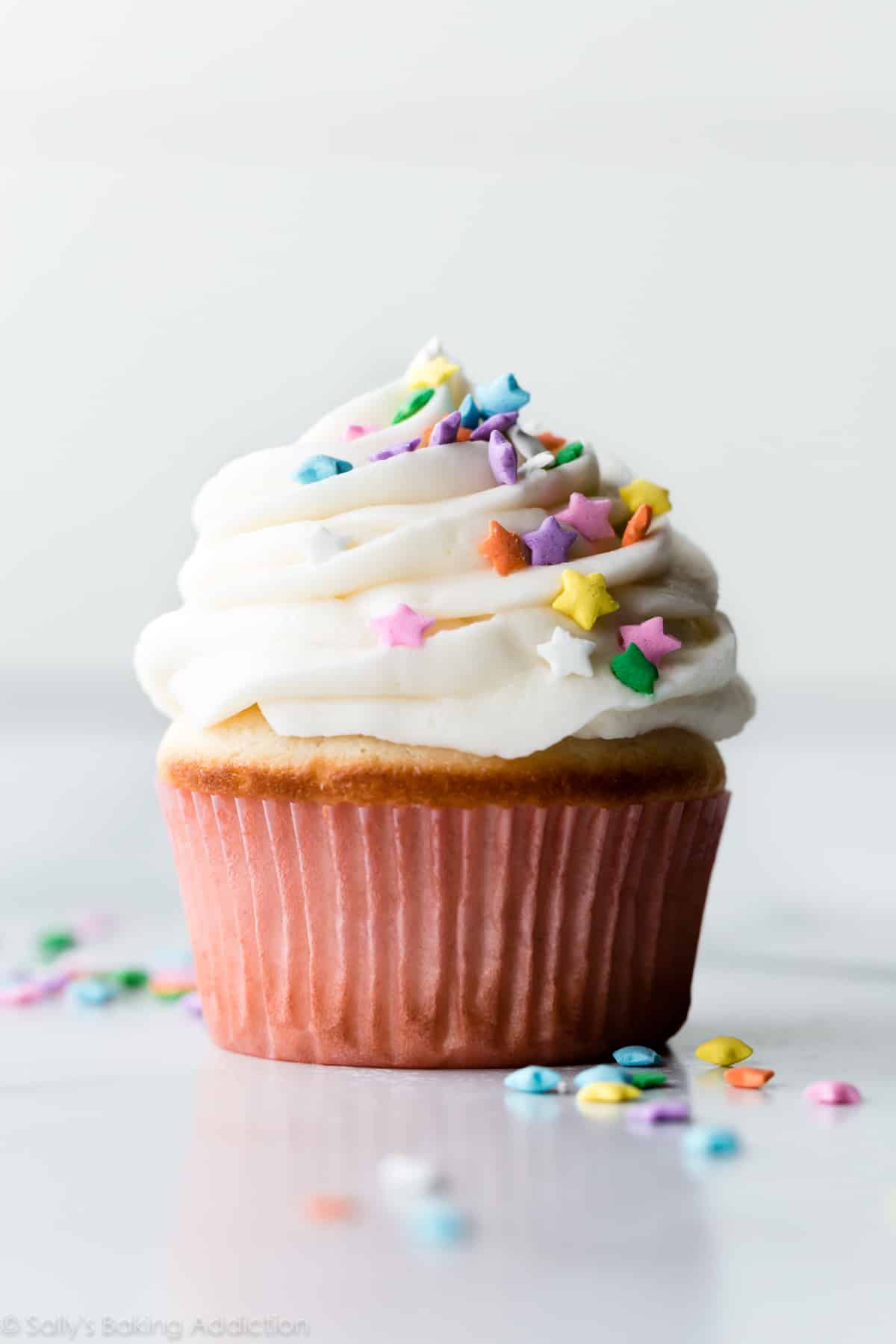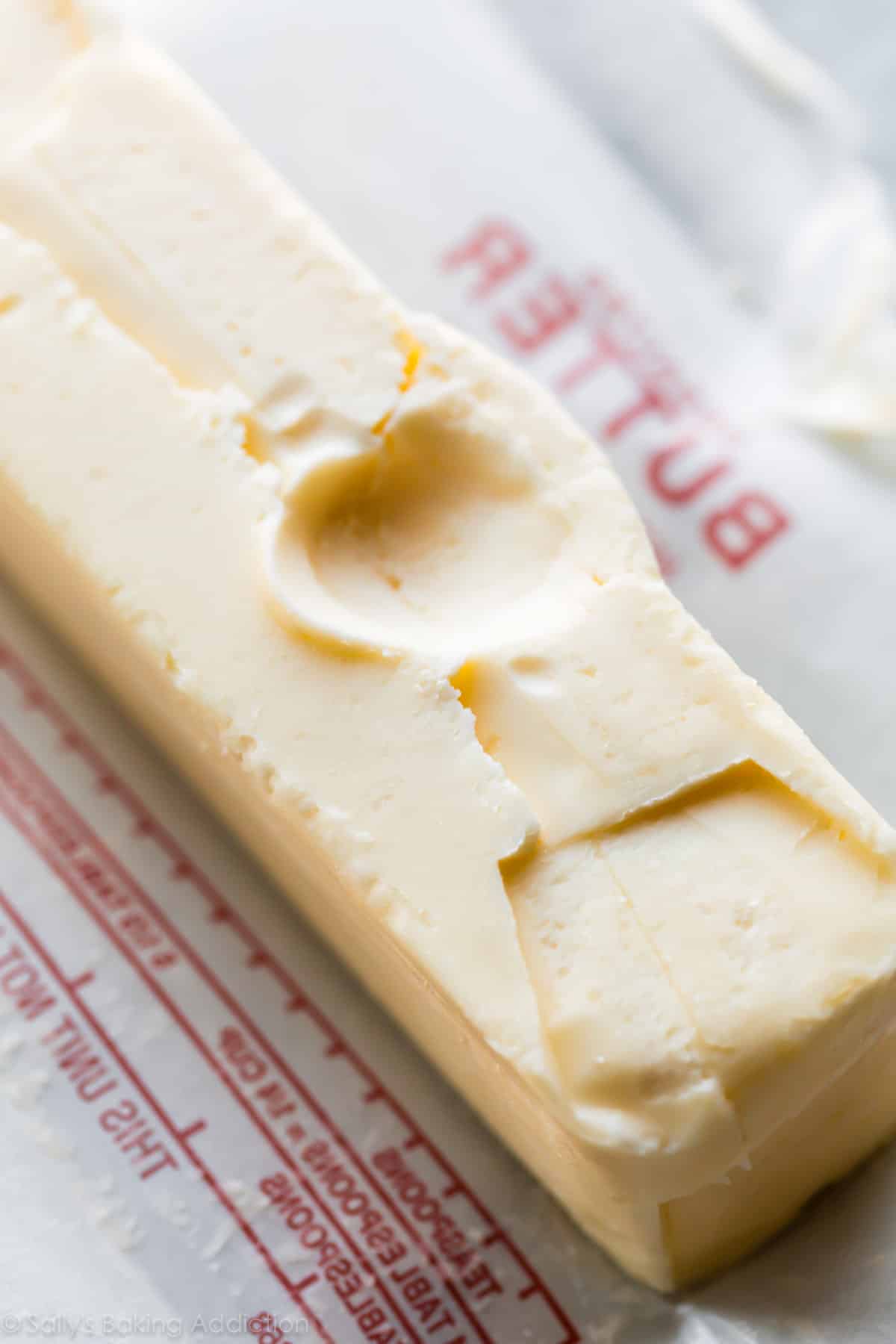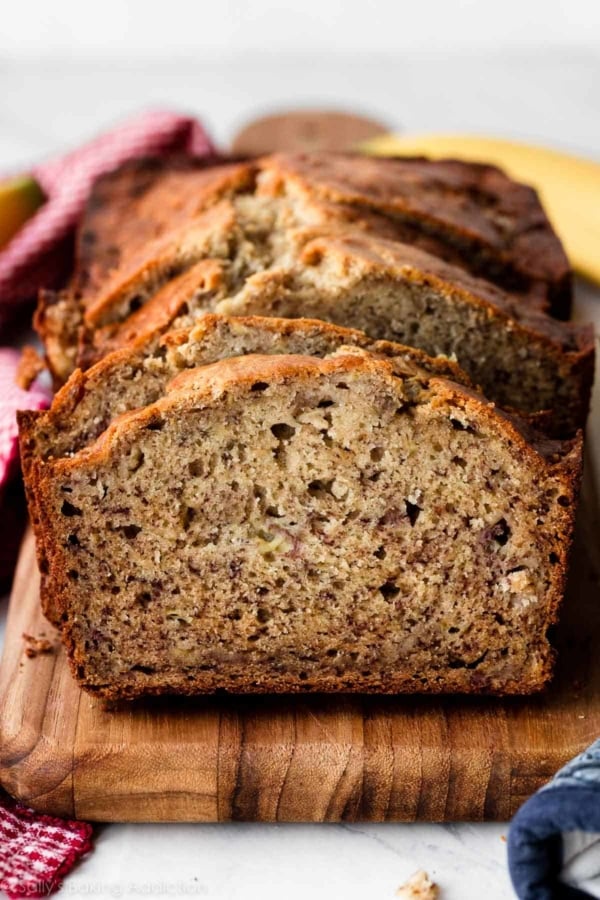Butter is the fine line between recipe success and recipe failure.

Did you know that the temperature and consistency of butter will MAKE or BREAK your recipe? This means that recipe success or recipe failure is literally in the hands of your butter. And I’m not exaggerating.
But the good news is that you can control this!
Whenever I work through recipe failures with bakers like you, I always ask about the butter. Most baking and dessert recipes begin with room temperature butter. This does not mean very soft butter. In fact, room temperature butter is supposed to be cool to the touch.
And this is where some recipes are doomed from the very beginning.

These are my Vanilla Cupcakes with Vanilla Buttercream.
Why is Room Temperature Butter Important?
“Butter softened to room temperature” is not listed just for fun. Recipe authors aren’t trying to make your life difficult when calling for room temperature ingredients. In fact, there’s legitimate science involved.
Most baking recipes begin with creaming butter and sugar together. It’s such an important step in many baking recipes, that I dedicated an entire post on how to cream butter and sugar. Butter, a solid fat, is capable of holding air and the creaming process is when butter traps that air. While baking, that trapped air expands from the heat and produces a fluffy baked good. Not only this, room temperature ingredients bond together very easily since they’re warmer, creating a seamless and evenly textured batter. A smooth batter with trapped air = a uniformly textured and proper tasting baked good. Cold ingredients do not emulsify together. Period. This results in clumpy frosting, chunky cheesecake, dense cake, flat breads, and oily muffins.
In other words, complete recipe failures.
It’s literally my #1 rule in my 10 best baking tips: if a recipe calls for room temperature butter, use room temperature butter. It’s *that* important.

Room Temperature Butter is Colder than You Think
Room temperature butter is cool to the touch and about 65°F (18°C), which might be colder than your kitchen. If your cakes are dense, you’re probably softening the butter too much. And butter that’s too warm causes cookies to overspread. But guess what? You have complete control to prevent these problems.
Room temperature butter is a must for red velvet cake.

How to Bring Butter to Room Temperature
Sit out: Allow the butter to sit out on the counter for about 1-2 hours before beginning your recipe. The amount of time depends on the weather and how cool you keep your kitchen.
Test it: To test the butter, poke it with your finger. Your finger should make an indent without sinking or sliding down into the butter. The butter should not be shiny or greasy. It will be cool to touch, not warm.
- Sometimes our schedules don’t allow 1-2 hours for softening butter prior to beginning a recipe. Don’t take a shortcut and microwave the butter because it will not heat evenly. Even the slightest bit of melted butter means less aeration in your baked good. And, after reading above, you know that’s a big problem! But guess what? I have a foolproof trick to soften butter quickly. Works like a charm.
Sometimes It’s OK to Skip the Fuss
Don’t have time to waste on room temperature butter? Here are several recipes calling for melted OR cold butter:
- Homemade Brownies
- Lace Cookies
- Chocolate Chip Cookies
- Homemade Biscuits
- Chocolate Chip Cookie Bars
- Coconut Macadamia Nut Cookies
- Banana Muffins
- Chocolate Chip Scones and Blueberry Scones
- No Bake Peanut Butter Bars
- Cornbread
- Pumpkin Chocolate Chip Cookies
- M&M Cookie Bars
- mostly all of these pie recipes
And Always Remember
If a recipe calls for room temperature butter, make sure all other ingredients are room temperature as well. This includes eggs, milk, and sour cream. When cold ingredients touch creamed butter, the butter will cool down and solidify again. And, as you read above, this sabotages the recipe. Place eggs in warm water for 10 minutes and/or microwave dairy ingredients (not butter!) for about 10 seconds prior to using.

More Tips to Make YOU a Better Baker
- Salted vs Unsalted Butter
- My 10 Best Baking Tips
- Why Room Temperature Ingredients Make a Difference
- 14 Best Baking Tools Every Baker Needs
- How to Freeze Cookie Dough
- How to Cream Butter and Sugar
Q: What do you think about room temperature butter? I hope this has been helpful to you. Now get your bake on this weekend!



















Reader Comments and Reviews
I am 66 years old, and I’ve been messing around in the kitchen since I was 9 years old. I can do breads, cakes, pies, cookies, bagels, scones, muffins and puff pastry. With all that being said, I have to admit that I never stopped for one minute to consider what “room temperature” butter really meant. So, for years I used soft butter. Along with that, as far as creaming butter and sugar, I figured that enough is good, more is better, too much is just right. Well, I am embarrassed to admit I was wrong, so wrong. I have been doing Christmas cookies this past week and I read your instructions for the first time. Well, guess what. Everything has turned out GREAT. Go figure. Thanks for teaching this old lady that you are never too old to learn a better way, even from a young whipper snapper like you.
So happy to read you found this helpful, Sandra!
I just made your snickerdoodle dough, and the batter was nothing but crumbs after mixing. It wouldn’t even come together. Could my butter have been too soft? It had sat out all day, then my kitchen was warm after preheating the oven. Butter was super soft and almost greasy. But would that cause the batter to be crumbly? I divided it into 1/2, rolled it up into logs and it’s in the fridge.
Hi Sapat, if your butter was super soft and almost greasy, that means it was definitely too warm. We’re not sure that would cause the batter to be crumbly, however. Is it possible you over-measured the flour, and had too much dry ingredient?
I have been baking chocolate chip cookies for the last 60 years! Thousands of cookies! For the last 6 times I baked… They were hard as a rock, tasted horrible, spread, etc. I switched, flour, butter, sugar to a different brand. tried again today… they were some better, but not what they used to be. Besides being expensive to throw away so much, I’m completely at loss. Sure would appreciate suggestions.
Hi Bonnie! Have you been using the same recipe this whole time? Here’s 5 Cookie Baking Tips to Improve Your Next Batch, and also our recipe for Chocolate Chip Cookies that you may enjoy trying.
This is really helpful, thank you! I recently made a batch of chocolate cookies that had great taste/texture but they spread a lot and were a little greasy. After reading this post, I think my “room temp” butter was a little too warm. However, I allowed the formed balls of dough to chill in the fridge overnight before baking. Does the amount of chill time mitigate the effects of the too-warm butter? Or does the chill time not help to prevent spreading, because the butter was too warm during the creaming process?
Hi Nata, the temp of the butter you start with matters even if the dough is chilled. Starting with proper room temperature butter is our #1 tip for baking cookies!
Thank you! I found this blog post because I’ve been trying to diagnose my cookie problem, and I think this is the answer. Excited to try the recipe again, as the final predict aside from the altar.
Hi! Wow, I always just though “So long as it’s soft” it was perfectly fine to use any temperature of butter. Now that its summer and our kitchen’s warm and humid, the butter get soft much quicker, and ALOT softer, so that it’s greasy and wet. Thank you for these tips! I never knew over-soft butter would result in dense cakes!
Happy to hear that this was helpful, Margaret!
Hi Sally!
Thank you for these tips, especially the one about butter temperature and creaming. I made the strawberry cake and loved it but it was a little dense and it turns out I regularly over-cream the butter so I guess that was why! Next time.
Best,
Nancy
So glad this was helpful, Nancy!
Hi,can I use salted butter in place of unsalted in the whole wheat bread recipe?
Hi Jennifer, yes, that should be fine.
Thank you for this, super helpful. I wonder if I am keeping my kitchen too cold because my room temperature butter NEVER properly blends with the sugar. Maybe it’s my hand mixer, but it always comes out in clumps. I try pre-breaking the butter into smaller pieces but it doesn’t matter, it sprays sugar everywhere and then little balls of butter. Maybe the microwave sauna trick could help. I don’t bake often enough to invest in a stand mixer.
Your explanation of things like this has changed my baking game! This one tip and the proper measurement of flour blew my mind and solved so many problems I had in the past! So glad I found you years ago!
I love your recipes; I find myself not looking at other recipes very much. Thanks for the tip on softening butter. I am getting ready to make your Carmel snickerdoodle cookies. I made the maple pecan snickerdoodle cookies, they were yummy. Thank you for all your research to give us good recipes.
Thanks for this tip. Do you take out the boiling water cup and then place the plate with the cut up butter pieces ??
Hi Connie, correct—remove the water from the microwave and then quickly put in the butter and shut the door. The radiant heat will soften the butter in about 10 minutes.
Hi Sally! Can you substitute oil for butter? Thanks!
Hi Aria, in short, it really depends on the exact recipe. For example, in recipes where you need softened butter to cream with the sugars, liquid oil will not work in its place. For best results, it’s always recommended to follow the recipe as written. Hope this helps!
Most likely but why would you want to? Seed oils are highly processed and not in any way healthy. And olive oil would leave the wrong flavor profile.
thank you very much
One question on softening the butter quickly – I was unclear from your instructions as to whether I should leave the container of hot water in the microwave with the butter, or take it out?
Hi Betty! Take out the container of hot water, then add the butter when using our trick to soften butter quickly.
Thank you!
Thank you so much for this! I just started my baking journey and I’m so excited. But I have to admit I was really confused about what “room temperature butter” ACTUALLY meant. I thought if it was still cold then I had to wait longer. I’m so grateful you explained the true meaning for room temp butter.
Room temperature vs softened butter. Is there a difference? I have some recipes that call for “softened” butter and others that say “room temperature”, are they one and the same? Thanks!
Hi Jennie, different recipe authors may refer to it a bit differently. In our recipes we say “softened to room temperature” when you need room temperature butter. For recipes that need butter even softer than that, we say “extra soft.” Hope this helps!
Having no idea how long it would get to get to 65 degrees I had the great idea of using an instant-read thermometer on the butter. It’s currently at 60 so I’m almost there. 🙂
Good idea, did it work?
What about butter alternatives like country crock or crisco? Any thoughts on how to handle those? Or just bypass all together? Sometimes it’s all I have in the house and would be nice to work it into a recipe still
Hi Denni, those softer ingredients usually come to room temperature more quickly, but often are not a 1:1 swap with butter.
Sally, hi. I’m still not clear about one aspect of room temp butter. I understand 1 to 2 hours in advance – but what is the assumed “starting point” for that amount of time. Does that assume the butter was in the fridge (cold but not frozen) or does that assume the butter was frozen? I’m guessing it’s fridge cold and not frozen but wanted to check to be sure. Your “Big Fat Peanut Butter Oatmeal Chocolate Chip Cookies” are in my short term queue. Thank you.
Hi Phil, yes, that’s assuming the butter was stored in the refrigerator and came from the refrigerator. So, 1 to 2 hours from the fridge.
I literally always leave my butter our all day all night
If you’re leaving butter out all day and night then it’s salted butter and that has water in it compared to unsalted and margarine is nothing but oil, water and a smidge of cream frothed up at a cold temp to make it solidify. Unsalted butter will sour after a day or two left out.
Sally, I have followed you over the years and am delighted to see how popular you are now. Originally I sent you a request for a peanut butter frosting (hard to the touch)—- you didn’t have one. Do you have one today?
Hi Deborah, here is our favorite peanut butter frosting recipe. It’s creamy and not hard, but you could try replacing some of the butter for shortening for a “crustier” buttercream. Thank you for following along all these years!
Thank you so much for the definition of room temperature butter!! I would have let it sit out until it got soft. We do this before nuking it for popcorn! Big difference between popcorn and baking!!